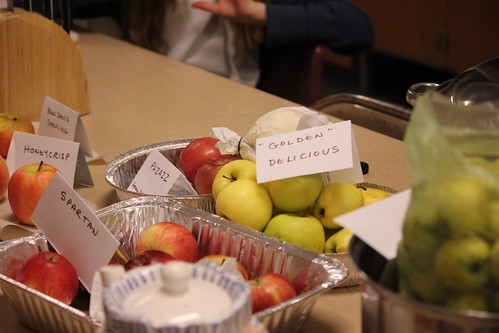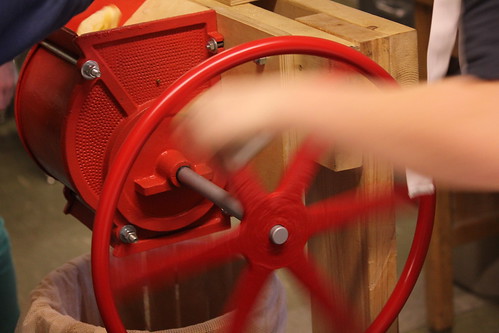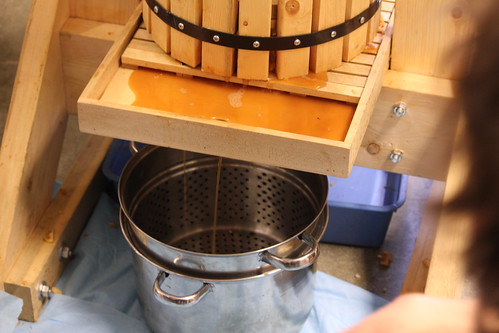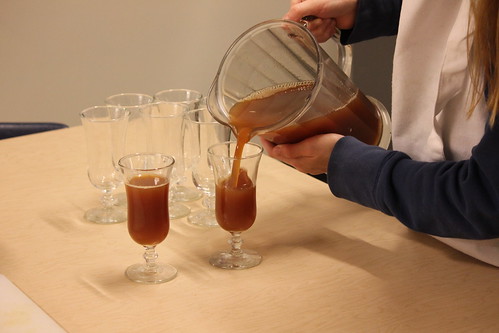
Last Tuesday was Terra Madre Day, the international celebration of local food. Wanting to showcase Pacific Northwest bounty, I asked my friend Larry Liang, who volunteers for the nonprofit City Fruit, if we could borrow their wooden cider press (I'd seen it in action at a recent fundraiser and knew the kids would love it). Being the awesome guy he is, Larry arranged for fellow volunteer Barbara Burrill to bring the press as well as local apples and expertise. What a treat.

Bugs love apples, which is why commercial orchards use so many pesticides, why apples top the
Environmental Working Group's "dirty dozen" list, and why we should buy organic whenever possible. Barb showed us a clever method of protecting against coddling moths: a lightly-waxed sandwich bag secured over the seedling. The bag allows sunlight, doesn't disintegrate in the rain, is organic and compostable. (It tickled me to learn this, as I had assumed when biking the Burke that the occasional paper-festooned tree was an art installation.)

We discussed the history of apples and why so few varieties are available in grocery stores, given that there are over 75,000 varieties and Washington State is the largest exporter in the nation. Apples have long been bred for beneficial qualities, but there is often a trade of taste for shelf life, which gave rise to the bland but easy-to-store Red Delicious, still Washington's most popular export (although Gala is gaining). Fortunately each year sees an increase in varieties available locally, and in our farmers markets, orchards like Collins, Booth Canyon in Okanogan, and Jerzy Boys in Chelan bring interesting heirloom varieties to sample and buy. Once you've tasted a complex, interesting apple, you will find it hard to consider anything with "Delicious" in its name as more than marketing.
 As expected, the kids had a great time with the cider-making process, from halving the apples, carving out and discarding the "yucky bits," loading the hopper, and turning the crank. It took a lot of muscle and everyone got a turn at the wheel.
As expected, the kids had a great time with the cider-making process, from halving the apples, carving out and discarding the "yucky bits," loading the hopper, and turning the crank. It took a lot of muscle and everyone got a turn at the wheel.
Then it was time to press, and as beautiful as any other kind of magic, the cider poured out, a rich amber, almost like caramel. We gathered around for a toast, clinking glasses and quaffing a beverage as old as apples themselves. Now it was time to get busy with the rest of our menu.

Sadly, my camera ran out of battery after this photo. I couldn't resist these gorgeous cabbages, one (the red one) four times as expensive as the other (Savoy). The rosemary is from a decades-old plant in my garden. But the real star of our meal was the Makah Ozette potato (the photo is from Slow Food).
 |
| Makah Ozette, photo courtesy Slow Food |
Short on time, we quickly scrubbed the Ozettes (mixing them with a variety of other fingerlings), plucked the pin-bones out of the salmon, and shredded the cabbage and carrots. Prep Lead Eric ran a tight ship, and twenty minutes later, the meal was ready. Plate Lead Alena set a lovely table (with proper utensil placement, a vanishing skill!). Gratitude Lead Kosma gave thanks, and we dove in.
This cell phone photo doesn't do justice to the food, but wow. Talk about eating the rainbow. The flavors and textures were just as various, and lip-smacking. Almost everything was local and seasonal. It was the kind of meal you want to serve with wine, but, given our company and the occasion, we made do with a cocktail conjured of the remaining cider, stretched with lemon juice and tea. And it too, was good.
Following her nose (we had amped up the garlic on the potatoes), sixth grade math teacher Ms. Dowell found her way to the kitchen and accepted our invitation to the table, engaging in a lively chat with the students. It was gratifying to show off their work, which is not just the food but the attitude. These kids are learning survival skills in the purest sense: ways to nurture themselves and community and the biodiversity of our planet. Which, happily, is a lot of fun . . . both to teach and to learn.
(Big thanks to Larry, Barb, Nina, whose generosity made this a memorable class, and to Mary, who comes every week to help out and has probably never washed so many dishes in her life. You are all rockstars.)
RECIPES
Fresh Pressed Cider
Ingredients
10 pounds of apples (the tarter the better)
10 pounds of apples (the tarter the better)
Directions
- Prepare cider press with large pot for catching cider.
- Wash and cut apples, removing any insect-damaged parts.
- Feed apples into the hopper of cider press.
- Take turns turning crank to grind the fruit into a pulp, called mast.
- Crank pressing plate down on the mast to free up the juices.
- Pour cider into glass and enjoy!
***
Simple Baked Salmon
A perfect local food to celebrate Terra Madre day, wild salmon needs little to enhance its umami. This recipe can be made with frozen thawed or fresh wild salmon. Serves 4.
Ingredients
- Four 3-oz wild salmon fillets
- Olive oil
- Coarse salt
- Freshly ground black pepper
- Lemon, quartered
Directions
Preheat oven to 400 degrees. Line a baking sheet with foil or paper, brush with oil. Lay salmon skin-side down and season with salt and pepper. Bake until cooked through, about 15 minutes. Serve with lemon.
***
Roasted Ozette Fingerlings
Flavorful, nutritious, and easy to cultivate in home gardens, the Ozette potato, brought to the area by Peruvian explorers and cultivated for 200 years by the Makah tribe, is definitely worthy of saving from extinction. Serves 6-8.
Ingredients
- 2 pounds Ozette potatoes, washed and cut in quarters length-wise
- 2 tablespoons olive oil
- 2 sprigs fresh rosemary, chopped
- 8 garlic cloves, minced
- salt and freshly-ground pepper to taste
Directions
Preheat oven to 400 degrees. Line large baking sheet with foil. Toss potatoes with rosemary, olive oil, garlic, salt and pepper. The potatoes should be a single layer (use two sheets if needed). Roast for 20 minutes or until crispy outside and tender inside.
***
Coleslaw with Cranberries & Hazelnuts
Cranberries and hazelnuts are grown in the Pacific Northwest; local foods perfect for celebrating Terra Madre day. This recipe is colorful, kid-friendly, and adaptable to what you have on hand. Serves 4.
Ingredients
- 1/4 cup mayonnaise
- 2 tablespoons lemon juice
- 1 tablespoon Demerara (or regular) sugar
- Salt and freshly ground black pepper to taste
- 3 cups shredded cabbage (a colorful mix is nice)
- 1 large carrot, peeled and grated
- 1/3 cup dried cranberries
- 1/4 cup chopped hazelnuts (or pecans, walnuts, or almonds)
Directions
- Toast nuts briefly in a dry pan or under a broiler. Set aside to cool.
- In your serving bowl, whisk together mayonnaise, lemon juice, sugar, and salt.
- Add cabbage, carrots, green onions, cranberries, and nuts, and toss to coat.
- Ideally, allow to sit for 30 minutes before serving so flavors can meld.
***

I am so impressed with what you guys are doing! This is amazing--and what a gift to the kids.
ReplyDeleteI never had a single cooking class in school. I would have loved it.
And this is more--history, culture, agriculture. Incredible (and quite a production!).
Thank you, Tara. It is definitely the high point of my week!
ReplyDelete--Julie